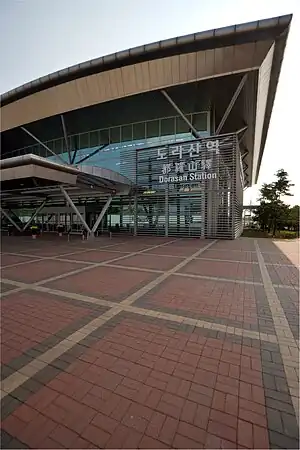| |||||||||||||||||||||||||||||||
|---|---|---|---|---|---|---|---|---|---|---|---|---|---|---|---|---|---|---|---|---|---|---|---|---|---|---|---|---|---|---|---|
 The entrance to Dorasan station | |||||||||||||||||||||||||||||||
| Korean name | |||||||||||||||||||||||||||||||
| Hangul | |||||||||||||||||||||||||||||||
| Hanja | |||||||||||||||||||||||||||||||
| Revised Romanization | Dorasannyeok | ||||||||||||||||||||||||||||||
| McCune–Reischauer | Torasannyŏk | ||||||||||||||||||||||||||||||
| General information | |||||||||||||||||||||||||||||||
| Location | Nosang-ri, Jangdan-myeon, Paju, Gyeonggi Province South Korea | ||||||||||||||||||||||||||||||
| Coordinates | 37°53′55″N 126°42′36″E / 37.898715°N 126.710075°E | ||||||||||||||||||||||||||||||
| Operated by | |||||||||||||||||||||||||||||||
| Line(s) | Gyeongui–Jungang Line, Pyongbu Line | ||||||||||||||||||||||||||||||
| Platforms | 2 (2 side platforms) (1 not in use) | ||||||||||||||||||||||||||||||
| Tracks | 2 (1 not in use) | ||||||||||||||||||||||||||||||
| Construction | |||||||||||||||||||||||||||||||
| Structure type | Surface | ||||||||||||||||||||||||||||||
| History | |||||||||||||||||||||||||||||||
| Opened | April 11, 2002 (Southern tracks), December 11, 2007 (Northern tracks) | ||||||||||||||||||||||||||||||
| Electrified | December 11, 2021 | ||||||||||||||||||||||||||||||
| Services | |||||||||||||||||||||||||||||||
| |||||||||||||||||||||||||||||||
Dorasan Station is a railway station situated on the Gyeongui–Jungang Line, which formerly connected North Korean and South Korean rail systems and has since been restored. Dorasan station is located approximately 650 meters (710 yards) from the southern boundary of the Korean Demilitarized Zone and is currently the northern terminus of Korail's Gyeongui-Jungang Line, which is served by Shuttle Service to Imjingang Station. North of here the former Gyeongui Line continues as the Korean State Railway's P'yŏngbu Line, but this connection is not in regular service. The current purpose of the station is largely symbolic of the hope for eventual Korean reunification.
History
On December 11, 2007, freight trains began traveling north past Dorasan station into North Korea, taking materials to the Kaesong Industrial Region, and returning with finished goods. It was scheduled to make one 16-kilometer (9.9 mi) trip every weekday.[1]
On December 1, 2008, however, the North Korean government closed the border crossing after accusing South Korea of a confrontational policy.[2] This coincided with the 2008 South Korean legislative election, and a change to a more conservative government. After that it was opened and closed again repeatedly, with the most recent reopening having been on 16 September 2013.[3]
On December 11, 2021, a new 3.7 km (2¼ mile) Gyeongui–Jungang Line shuttle service between Imjingang Station and Dorasan Station began operations. This service operates only once during weekends and public holidays.
Train services
The station is currently served by four daily trains from Seoul, which are used mostly by tourists.[4]
Gallery
 Outside Dorasan station
Outside Dorasan station Dorasan station marker
Dorasan station marker A view from Dorasan station's parking lot
A view from Dorasan station's parking lot Inside Dorasan station
Inside Dorasan station Gates to the platform
Gates to the platform P'yŏngbu Line tracks that could bring trains to Pyongyang
P'yŏngbu Line tracks that could bring trains to Pyongyang A photo of U.S. President George W. Bush and South Korean president Kim Dae-jung visiting the Dorasan station
A photo of U.S. President George W. Bush and South Korean president Kim Dae-jung visiting the Dorasan station Pyeongyang sign in the Dorasan station. Notice the name of the capital of North Korea written in the Southern dialect.
Pyeongyang sign in the Dorasan station. Notice the name of the capital of North Korea written in the Southern dialect. Commuter Train
Commuter Train Entrance of Dorasan station
Entrance of Dorasan station Hall of Dorasan station
Hall of Dorasan station Map of the Eurasian rail network after Korean reunification in Dorasan station
Map of the Eurasian rail network after Korean reunification in Dorasan station
See also
References
- ↑ "Cargo trains begin service in Koreas - Yahoo! News". Archived from the original on 2007-12-13. Retrieved 2007-12-11.
- ↑ HighBeam
- ↑ K.J. Kwon (16 September 2013). "North and South Korea reopen Kaesong Industrial Complex". CNN. Retrieved 17 January 2014.
- ↑ http://info.korail.com/servlets/renew.sta.sta02000.sw_sta02207_v1Svt?code=0403&name=%B5%B5%B6%F3%BB%EA%5B%5D
External links
![]() Media related to Dorasan Station at Wikimedia Commons
Media related to Dorasan Station at Wikimedia Commons